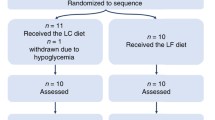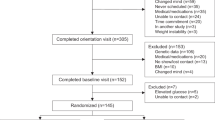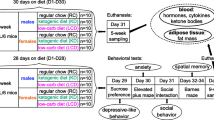Abstract
EXCESS of carbohydrate in the diet has been considered to be of significance in the ætiology of certain types of skin disorder1. With this in mind the opportunity was taken to examine the fatty acid composition of the sebum in subjects who were on experimental diets containing a relative excess of carbohydrate.
This is a preview of subscription content, access via your institution
Access options
Subscribe to this journal
Receive 51 print issues and online access
$199.00 per year
only $3.90 per issue
Buy this article
- Purchase on SpringerLink
- Instant access to full article PDF
Prices may be subject to local taxes which are calculated during checkout
Similar content being viewed by others
References
Barber, H. W., in Taylor's Practice of Medicine, edit. by Poulton, E. P., 937 (J. and A. Churchill, London, 1930).
Macdonald, I., and Braithwaite, D. M., Clin. Sci., 27, 23 (1964).
Hirsch, J., Farquhar, J. W., Ahrens, E. H., Peterson, M. L., and Stoffel, W., Amer. J. Clin. Nutr., 8, 499 (1960).
Weitkamp, A. W., Smiljanic, A. M., and Rothman, J., J. Amer. Chem. Soc., 69, 1936 (1947).
Author information
Authors and Affiliations
Rights and permissions
About this article
Cite this article
MACDONALD, I. Changes in the Fatty Acid Composition of Sebum associated with High Carbohydrate Diets. Nature 203, 1067–1068 (1964). https://doi.org/10.1038/2031067b0
Issue date:
DOI: https://doi.org/10.1038/2031067b0
This article is cited by
-
No skin off your back: the sampling and extraction of sebum for metabolomics
Metabolomics (2023)
-
Resistin gene polymorphisms are associated with acne and serum lipid levels, providing a potential nexus between lipid metabolism and inflammation
Archives of Dermatological Research (2016)
-
Acne vulgaris
Nature Reviews Disease Primers (2015)



